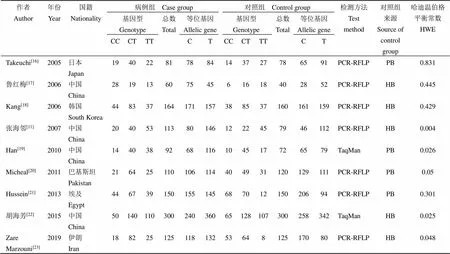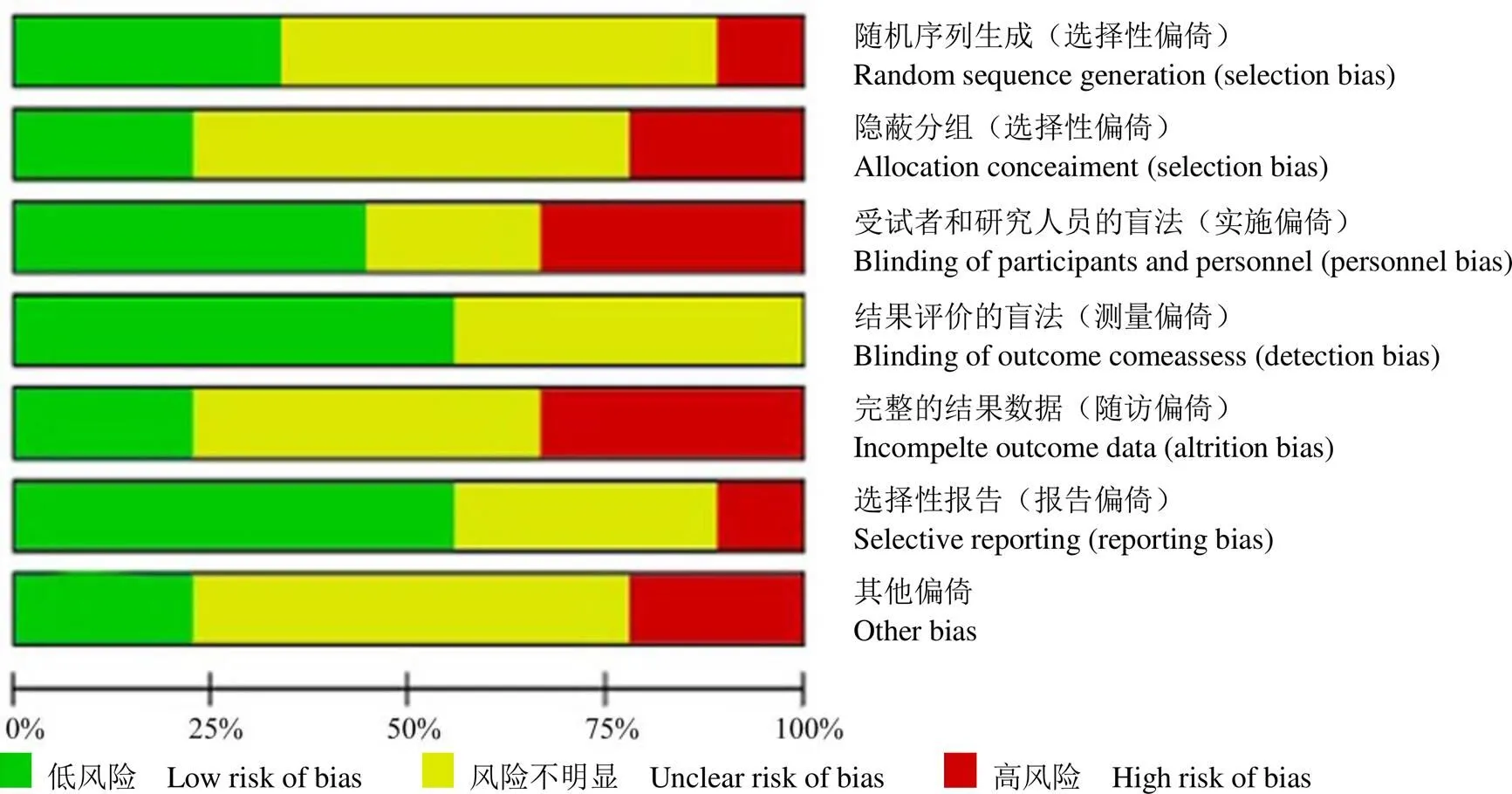Meta分析CD14基因-159C/T多态性与变应性鼻炎易感性关系
2023-10-13单立影徐景利赵亚娟田海芳
单立影,徐景利,赵亚娟,田海芳
·论著·
Meta分析CD14基因-159C/T多态性与变应性鼻炎易感性关系
单立影,徐景利,赵亚娟,田海芳
101300 北京中医医院顺义医院耳鼻喉科
Meta 分析CD14 基因-159C/T 多态性与变应性鼻炎(AR)易感性关系,为AR的发病机制及疾病预防提供理论依据。检索PubMed、EMBASE、Cochrane 等国外数据库及中国期刊全文数据库、中国科技期刊数据库、中国生物医学文献数据库、万方数字期刊全文数据库等中文数据库中发表的CD14 基因-159C/T 多态性与变应性鼻炎易感性关系的病例对照研究。根据纳入和排除标准对文献进行筛选,用Jadad quantity 对纳入的文献进行偏差评估和敏感性分析,用Revman5.3 软件对数据进行处理。根据纳入和排除标准,共纳入 9 篇文献,共 2319 名受试者,其中病例组 1195 例,对照组 1124 例。Meta 分析结果显示:优势基因模型下(CC vs CT + TT),组合 OR 值为 0.74,95% CI 为[0.61,0.90],= 0.002,差异有统计学意义;超显性基因模型下(CT vs CC + TT),联合 OR 值为 1.12,95% CI为[0.95,1.32],= 0.18,差异无统计学意义;隐性基因模型下(TT vs CC + CT),联合 OR 值为 1.14,95% CI 为[0.95,1.38],= 0.15;等位基因(C 对 T),合并 OR 值为 0.95,95% CI 为[0.83,1.10],= 0.50,差异无统计学意义。表明与 T 等位基因相比,在 a 位点携带 C 等位基因不会增加 AR 的易感性。优势基因模型可能增加基因型 CD14 基因-159C/T 的 AR 易感性,而隐性基因模型和超显性基因模型可能不会增加基因型 CD14 基因-159C/T 的 AR 易感性。CD14 基因-159C/T 多态性与AR 易感性无显著相关性。基因座中的基因型可能增加AR 易感性的基因模型是优势基因模型。
CD14 基因-159C/T; 多态性; 变应性鼻炎; Meta 分析
变应性鼻炎(AR)是指变应性个体暴露于过敏原后,介质(主要是组胺)释放,并有多种免疫活性细胞和细胞因子参与的由免疫球蛋白E(IgE)介导的慢性鼻黏膜炎性疾病,以阵发性打喷嚏、流涕和鼻塞为主要症状[1]。近年来AR 患病率显著增高,在全球范围内呈高发趋势,严重影响了患者的生活质量[2]。我国对变应性鼻炎的流行病学调查表明,其多见于儿童和青少年,并且该病还可诱发哮喘。变应性鼻炎患者患哮喘的风险是无鼻炎史患者的3 ~ 5 倍[3]。
越来越多的证据表明,遗传易感性与环境因素的相互作用是导致AR 的根本原因[4]。因此寻找与人类复杂疾病密切相关的基因位点是研究其遗传机制及防治的重要途径之一[5-8]。由于启动子区是调控蛋白表达的关键因子之一,已经发现了许多与AR 易感性相关的基因位点[9]。其中,编码白细胞分化抗原簇14 基因(CD14)启动子区的159C/T 多态性基因已引起广泛关注,但不同区域的研究结论存在较大差异[10-13]。
AR 与支气管哮喘(BA)的密切关系在临床上早已被共识。1997 年,Thomas等[14]首次明确提出“一个气道,一种疾病”的思想。支气管哮喘的遗传学研究已经广泛开展[15]。因此,研究CD14 基因-159C/T 多态性与变应性鼻炎易感性的关系具有重要意义。
1 资料与方法
1.1 资料
中国期刊全文数据库、中国科技期刊数据库、万方数字期刊全文数据库、百度学术数据库、中国生物医学文献数据库(CBM)、维普资讯、中国网(CNKI)、PubMed、Medline、EMBASE、Web of Science、Cochrane 数据库从数据库建立到2021 年 12 月发表的所有 CD14 基因-159C/T多态性与变应性鼻炎易感性关系的病例对照研究文献。
1.2 方法
1.2.1 检索策略 以中文关键词“变应性鼻炎”“基因多态性”“CD14”和英文关键词“combined rhinitis”“CD14”“genes”“gene variants”“polymers”为检索词进行文献检索。人工检索寻找符合纳入标准的潜在文献。出现分歧时讨论解决,或由第三位研究者加入协商决定。
1.2.2 文献纳入标准 ①CD14 基因-159C/T 多态性与AR 易感性关系的相关研究;②符合AR 的诊断标准;③研究方法相似,论文数据完整,有病例组和对照组基因型频率分布数据。
1.2.3 文献排除标准 ①病例报告和复习文献;②未设立对照组或对照组不健康;③研究数据不完整。
1.3 统计学处理
应用RevMan 5.3 软件分析基因型和等位基因,并绘制森林图。采用统计量I2检验研究间的异质性。以α = 0.05 作为检验水准;< 0.05 表示差异有统计学意义。采用基因模型计算OR 值;文献是否发表偏倚采用漏斗图评估。
2 结果
2.1 收录文献的基本特征
根据文献的纳入和排除标准,最终纳入英文文献6 篇,中文文献3 篇,病例组1195 例,对照组1124 例。每篇文献基本信息、等位基因和基因型、控制来源等见表1。
2.2 纳入文献的质量评价
在纳入的9 篇文献中,采用随机数或计算机获得随机方法或随机分配访问次数,然后按照质量评价标准对所有纳入的随机对照试验文献进行评价和分析。评估纳入文献的每一项方法学特征,将评估结果输入软件,生成偏倚风险评价图。图1 中每一行代表一种偏倚风险,这些偏倚风险贯穿整个临床试验,反映临床试验的方法学质量。
2.3 Meta 分析结果
2.3.1 基因模型分析结果 检验等位基因和三基因模型的异质性,I2≥ 50%(图2 ~ 5)。因此,随机效应模型被用于 Meta 分析。

表1 纳入文献的基本特征
注:HWE < 0.05 指不符合 HWE;PB 表示以人群为基础的研究;HB 表示以医院为基础的研究。
Notes: HWE < 0.05 refers to non HWE compliance; PB represents population based research; HB represents hospital based research.

图1 质量评估分析
Figure 1 Quality assessment analysis

图2 基因模型 CC vs CT + TT 和 AR 关联研究森林图
Figure 2 Research on the association of gene model CC vs CT + TT and AR in forest map

图3 基因模型 CT vs CC + TT 和 AR 关联研究森林图
Figure 3 Research on the association of gene model CT vs CC + TT and AR in forest map

图4 基因模型 TT vs CC + CT 和 AR 关联研究森林图
Figure 4 Research on the association of gene model TT vs CC + CT and AR in forest map

图5 基因模型等位基因 C vs T 与 AR 关联研究森林图
Figure 5 Research on the association between allele C vs T and AR in forest map
在优势基因模型(CC vs CT + TT)中,OR 合并值为0.74,95% CI 为[0.61,0.90],= 0.002,差异具有统计学意义(图2)。结果表明CD14 基因-159 C/T 位点的优势基因模型(CC vs CT + TT)可能增加AR 易感性。
在超显性基因模型(CT vs CC + TT)中,合并OR 值为1.12,95% CI 为[0.95,1.32],= 0.18,差异无统计学意义(图3)。结果表明CD14 基因-159 C/T 位点的超显性基因模型不会增加AR 易感性。
在隐性基因模型(TT vs CC + CT)中,组合OR 值为1.14,95% CI 为[0.95,1.38],= 0.15,差异无统计学意义(图4)。结果表明CD14 基因-159 C/T 位点的隐性基因模型不会增加AR 易感性。
在等位基因(C vs T)中,合并 OR 值为 0.95,95% CI 为[0.83,1.10],= 0.50,差异无统计学意义(图5)。结果表明 CD14 基因-159 C/T 位点的等位基因不会增加 AR 易感性。
2.3.2 敏感性分析 执行敏感性分析以检查稳定性。共9 篇文献,1 组等位基因和基因型模型,将其依次进行分组和剔除。对每篇文献再次进行Meta 分析,比较消除前后的联合效应值。最后,分析了每次比较的联合效应值没有显著变化,表明研究结果在统计上的可信性且不受单个研究结果的影响。
2.3.3 发表偏倚 评价发表偏倚时的漏斗图见图6。漏斗图的散点分布对称时,说明没有显著的发表偏倚,CD14 基因-159C/T 基因模型与AR 关联研究的漏斗图基本对称。
3 讨论
AR 是一种发病机制极其复杂,非传染性上呼吸道炎症性疾病[21-22]。CD14 是革兰氏阴性菌内毒素脂多糖(LPS)首先发生反应的受体,CD14 与 LPS 互相作用可激活细胞因子 IL-12 活性,引发 Th1 细胞引导的免疫应答反应,抑制免疫球蛋白 E(IgE)的产生,影响变应性疾病的发生[23-24]。Yazdani等[25]研究发现,CD14 基因启动子-159 位点上的多态性(C/T),可以增强自身的活性,并通过激活细胞因子 IL-12 活性,降低 IgE 的产生。目前已有大量研究表明,CD14 基因-159C/T 多态性与哮喘伴下呼吸道高反应性和非感染性炎性病变的易感性显著相关[26-27]。同时,有多项研究表明 AR 与哮喘存在重要关联[28-29],但对 CD14 基因-159C/T 多态性与 AR 易感性的相关研究较少,且存在不一致的观点。Kang 等[18]研究发现,CD14 基因-159C/T 多态性在儿童常年变应性鼻炎中具有重要作用,CC vs CT + TT 基因型有较高的皮肤点刺阳性率。也有研究发现 CD14 基因多态性和活性与变应患者血清总 Ig 浓度和症状无关。因此,我们采用Meta 分析方法,将国内外关于 CD14 基因-159C/T 多态性与 AR 易感性的所有相关文献进行分析,从中获取 AR 遗传机制的一些启示。

图6 基因模型漏斗图与 AR 关联研究
Figure 6 Research on the relationship between gene model funnel graph and AR
本研究共纳入 9 篇国内外文献,分析发现CD14 基因-159C/T 多态性与 AR 易感性无显著相关性。出现这种结果可能有以下原因[30-31]:①纳入的文献仅限于已发表的文献,研究样本总数量较少;②不排除 CD14 基因位点与其他位点相互协同效应。
综上所述,CD14 基因-159C/T 多态性与AR 易感性无显著相关性。基因座中的基因型可能增加AR 易感性的基因模型是显性基因模型(CC vs CT + TT)。同时,在研究基因多态性和AR 易感性时,应尽量考虑环境、种族、年龄等因素的影响。
[1] Gu YR, Li HB. Interpretation of Chinese guideline for diagnosis and treatment of allergic rhinitis (2022, revision). Chin J Ophthalmol Otorhinolaryngol, 2022, 22(2):209-211. (in Chinese)
顾瑜蓉, 李华斌.《中国变应性鼻炎诊断和治疗指南(2022年, 修订版)》解读. 中国眼耳鼻喉科杂志, 2022, 22(2):209-211.
[2] Liu P, Liu JQ, Zhang J, et al. Research progress of probiotics in the treatment of allergic rhinitis. Chongqing Med, 2023, 52(3):451-455,460. (in Chinese)
刘朋, 刘江琦, 张进, 等. 益生菌治疗变应性鼻炎的研究进展. 重庆医学, 2023, 52(3):451-455, 460.
[3] Bousquet J, Heinzerling L, Bachert C, et al. Practical guide to skin prick tests in allergy to aeroallergens. Allergy, 2015, 67(1):18-24.
[4] Feng HJ, Du CP, Bai SJ. Association between CD14 gene-159C/T polymorphisms and the susceptibility of allergic rhinitis: a meta-analysis. Chin J Ophthalmol Otorhinolaryngol, 2022, 22(3):236-241. (in Chinese)
冯会杰, 杜翠萍, 白素娟. CD14基因-159C/T多态性与变应性鼻炎易感性关系的meta分析. 中国眼耳鼻喉科杂志, 2022, 22(3):236- 241.
[5] Bousquet J, Barbara C, Bateman E, et al. AIRWAYS-ICPs (European Innovation Partnership on Active and Healthy Ageing) from concept to implementation. Eur Respir J, 2016, 47(4):1028-1033.
[6] Ji DX, Tan JR, Yu HW. Efficacy, safety and compliance of immunotherapy in the treatment of allergic rhinitis: a meta-analysis. Chin J Otolaryngol Head Neck Surg, 2019, 54(12):894-901. (in Chinese)
季东翔, 谈家瑢, 虞和伟. 免疫治疗在变应性鼻炎治疗中疗效、安全性及依从性的Meta分析. 中华耳鼻咽喉头颈外科杂志, 2019, 54(12):894-901.
[7] Wang CS, Wang XD, Zhang L. An introduction to allergic rhinitis and its impact on asthma (ARIA) guidelines-2016 revision. Chin J Otolaryngol Head Neck Surg, 2018, 53(10):798-800. (in Chinese)
王成硕, 王向东, 张罗. 《变应性鼻炎及其对哮喘的影响(ARIA)》指南2016年修订版解读. 中华耳鼻咽喉头颈外科杂志, 2018, 53(10):798-800.
[8] Liu C, He XS. Advances in genetic research on allergic rhinitis. World Latest Med Inf, 2021, 21(18):79-80,82. (in Chinese)
刘灿, 何晓松. 变应性鼻炎的遗传学研究进展. 世界最新医学信息文摘, 2021, 21(18):79-80, 82.
[9] Wang P, Nolan TM, Yin Y, et al. Identification of transcription factors that regulate ATG8 expression and autophagy in Arabidopsis. Autophagy, 2020, 16(1):123-139.
[10] Xu HF, Li YR, Yang K, et al. Association of MTHFR C677T,MTRR A66G and PAI-14G/5G gene polymorphism with ischemic stroke in southern Anhui population. J Mudanjiang Med Univ, 2022, 43(5):19-22,34. (in Chinese)
许慧芳, 李越然, 杨魁, 等. MTHFR C677T、MTRR A66G和PAI-14G/5G基因多态性与皖南地区人群缺血性脑卒中关联性研究. 牡丹江医学院学报, 2022, 43(5):19-22, 34.
[11] Zhang HL, Ni LY, Bao QY, et al. Association of CD14 gene polymorphism with atopic diseases in Chinese Han ethnic group children. Chin J Pediatr, 2007, 45(2):105-108. (in Chinese)
张海邻,倪丽艳,包其郁,等.CD14基因多态性与儿童特应性疾病的相关性.中华儿科杂志,2007,45(2):105-108.
[12] Hussein YM, Shalaby SM, Zidan HE, et al. CD14 tobacco gene-environment interaction in atopic children. Cell Immunol, 2013, 285(1-2):31-37.
[13] Chen XY. The association with the -159C/T polymorphism in the promoter region of the CD14 gene and juvenile idiopathic arthritis. Guangzhou: Guangzhou Medical College, 2010. (in Chinese)
陈香元. 白细胞分化抗原-14基因启动子区-159C/T多态性与幼年特发性关节炎相关性研究. 广州: 广州医学院, 2010.
[14] Thomas D, McDonald VM, Pavord ID, et al. Asthma remission: what is it and how can it be achieved? Eur Respir J, 2022, 60(5):2102583.
[15] Du YC, Liu HH. Research progress on epithelial derived cytokines in united airway diseases. Chin J Otorhinolaryngol Skull Base Surg, 2022, 28(1):128-132. (in Chinese)
杜昱聪, 刘环海. 上皮源性细胞因子在共同气道疾病中的作用及其研究进展. 中国耳鼻咽喉颅底外科杂志, 2022, 28(1):128-132.
[16] Takeuchi K, Suzuki S, Yagawa M, et al. A CD14 gene polymorphism is associated with the IgE level for Dermatophagoides pteronyssinus. Acta Otolaryngol, 2005, 125(9):966-971.
[17] Lu HM, Li ZM, Fang CF, et al. The correlation of ACE gene polymorphism and -159C/T polymorphism of CD14 gene promoter with allergic rhinitis. Tianjin Med J, 2006, 34(12):860-862. (in Chinese)
鲁红梅, 李志明, 方彩凤, 等.血管紧张素转换酶基因及CD14基因多态性与变应性鼻炎的关系. 天津制药, 2006, 34(12):860-862.
[18] Kang HJ, Choi YM, Chae SW, et al. Polymorphism of the CD14 gene in perennial allergic rhinitis. Int J Pediatr Otorhinolaryngol, 2006, 70(12):2081-2085.
[19] Han D,She W, Zhang L. Association of the CD14 gene polymorphism C-159T with allergic rhinitis. Am J Rhimol Allergy, 2010, 24(1):e1- e3.
[20] Micheal S, Minhas K, Ishaque M, et al. Promoter polymorphisms of the CD14 gene are associated with atopy in Pakistani adults. J Investig Allergol Clin Immunol, 2011, 21(5):394-397.
[21] Hussein YM, Shalaby SM, Zidan HE, et al. CD14 tobacco gene-environment interaction in atopic children. Cell Immunol, 2013, 285(1-2):31-37.
[22] Hu HF, Fan YQ, Wang Y, et al. Association of CD14 gene-159C/T polymorphism with allergic rhinitis in Xinjiang Uyghur and Hans.J Xinjiang Med Univ, 2015, 38(6):664-668. (in Chinese)
胡海芳, 范宇琴, 王燕, 等. 新疆维吾尔、汉族CD14基因-159C/T多态性与变应性鼻炎关联分析. 新疆医科大学学报, 2015, 38(6): 664-668.
[23] Zare Marzouni H, Farid-Hosseini R, Jabari-Azad F, et al. CD14 as a serum immune biomarker and genetic predisposition factor for allergic rhinitis. Iran J Otorhinolaryngol, 2019, 31(102):1-9.
[24] Pan JH, Yue XK, Zou JF. The combination of Yupingfeng granules and salmeterol fluticasone in the treatment of allergic rhinitis and its effect on IL-12 histamine. Zhejiang Clin Med J, 2018, 20(12):1958-1960. (in Chinese)
潘君海, 岳显可, 邹佳峰. 玉屏风颗粒联合沙美特罗替卡松治疗变应性鼻炎及对IL-12组胺的影响. 浙江临床医学, 2018, 20(12):1958-1960.
[25] Yazdani N, Amoli MM, Naraghi M, et al. Association between the functional polymorphism C-159T in the CD14 promoter gene and nasal polyposis: potential role in asthma. J Investig Allergol Clin Immunol, 2012, 22(6):406-411.
[26] Zhou J, Liu HC, Xia F, et al. Correlation between polymorphism of CD14 promoter-159C/T and respiratory Streptococcus pneumoniae infection. Chin J Nosocomiology, 2020, 30(19):2931-2935. (in Chinese)
周捷, 刘海潮, 夏飞, 等. CD14启动子-159C/T多态性与呼吸道肺炎链球菌感染的相关性. 中华医院感染学杂志, 2020, 30(19):2931-2935.
[27] Yang LJ, Li Y. Relationship between cytotoxic T lymphocyte associated antigen 4 gene polymorphism and susceptibility of children with allergic rhinitis complicated with asthma. J Med Forum, 2021, 42(21):1-4,8. (in Chinese)
杨丽君, 李奕. 细胞毒T淋巴细胞相关抗原4基因多态性与儿童变应性鼻炎合并哮喘易感性的关系研究. 医药论坛杂志, 2021, 42(21):1-4,8.
[28] Ma DN, Bai L. Studyon the relationshipbetween β2-AR gene polymorphism and the improving effectof pulmonary function inchildrenwithasthma. J Mod Med Health, 2021, 37(3):361-364. (in Chinese)
玛迪娜, 白玲. 哮喘患儿β2-AR基因多态性与其肺功能改善效果的关系研究. 现代医药卫生 2021, 37(3):361-364.
[29] Li Y, Chu SD, Zhang J. Analysis of allergen distribution and risk factors in patients with allergic rhinitis. China Mod Dr., 2022, 60(8):54-57. (in Chinese)
李英, 楚士东, 张洁. 变应性鼻炎患者变应原分布及其发病危险因素分析. 中国现代医生, 2022, 60(8):54-57.
[30] Park JS, Son JH, Park CS, et al. Clinical implications of single nucleotide polymorphisms in diagnosis of asthma and its subtypes. Yonsei Med J, 2019, 60(1):1-9.
[31] Becker KG, Simon RM, Bailey-Wilson JE, et al. Clustering of non-major histocompatibility complex susceptibility candidate loci in human autoimmune diseases. Proc Natl Acad Sci U S A, 1998, 95(17):9979-9984.
Meta analysis of the relationship between CD14 gene-159C/T polymorphism and susceptibility to allergic rhinitis
SHAN Li-ying, XU Jing-li, ZHAO Ya-juan, TIAN Hai-fang
Author Affiliation: Otolaryngology Department, Beijing Traditional Chinese Medicine Hospital Shunyi Hospital, Beijing 101300, China
To analyze the relationship between the 159C/T polymorphism of CD14 gene and the susceptibility to allergic rhinitis by Meta analysis, and to provide theoretical basis for the pathogenesis and disease prevention of allergic rhinitis (AR).We conducted a case control study on the relationship between CD14 gene-159C/T polymorphism and susceptibility to allergic rhinitis published in foreign databases such as PubMed, EMBASE, Cochrane, and Chinese databases such as the Chinese Journal Full-Text Database, the Chinese Scientific and Technological Journal Database, the Chinese Biomedical Literature Database, and the Wanfang Digital Journal Full-Text Database. Appropriate inclusion and exclusion criteria were selected for the literature, literature screening was performed according to the above criteria, deviation evaluation and sensitivity analysis on the included literature table was conducted with Jadad quantity, and the data were processed with Revman5.3 software.According to the inclusion and exclusion criteria, a total of 9 articles with 2319 subjects were included, including 1195 in the case group and 1124 in the control group. The results of Meta analysis showed that under the dominant gene model (CC vs CT+TT), the combined OR value was 0.74 and 95% CI was [0.61, 0.90] with a statistically significant difference (= 0.002). In the super dominant gene model (CT vs CC + TT), the combined OR value was 1.12 and the 95% CI was [0.95, 1.32] with no statistically significant difference (= 0.18). In the recessive gene model (TT vs CC + CT), the combined OR value was 1.14, the 95% CI was [0.95, 1.38], and the value ofwas 0.15. The combined OR value of alleles (C versus T) was 0.95 with a 95% CI of [0.83, 1.10], and the value ofwas 0.50. The difference was not statistically significant. This indicated that carrying the C allele at the a locus did not increase the susceptibility to AR as compared to the T allele. Dominant gene models might increase the AR susceptibility of genotype CD14 gene-159C/T, while recessive gene models and superdominant gene models might not increase the AR susceptibility of genotype CD14 gene-159C/T.The 159C/T polymorphism of CD14 gene is not significantly correlated with AR susceptibility. The gene model in which genotype at a locus may increase AR susceptibility is dominant.
CD14 gene-159C/T; polymorphism; rhinallergosis; meta analysis
SHAN Li-ying, Email: shanliying2008@tom.com
10.3969/j.issn.1673-713X.2023.05.005
单立影,Email;shanliying2008@tom.com
2023-03-27
